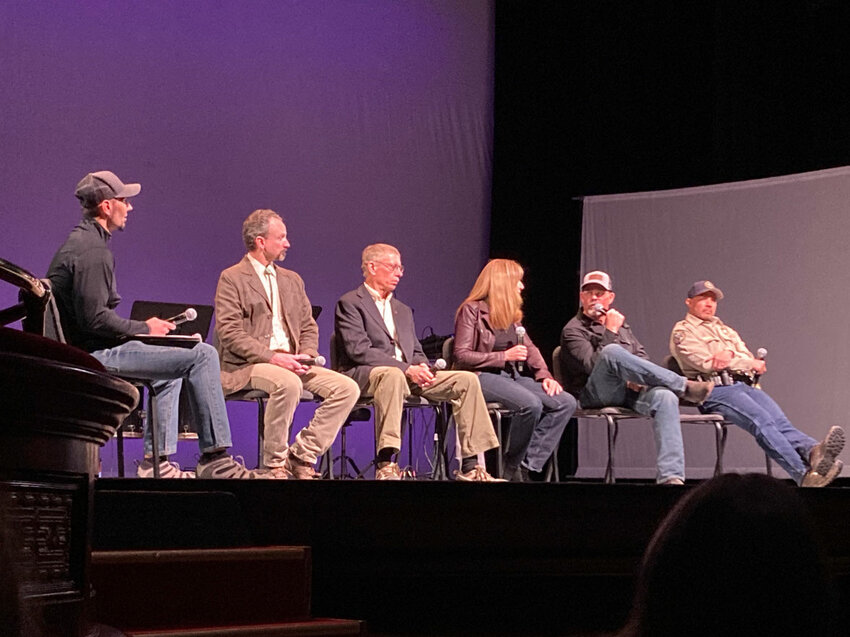
Aspen Public Radio
Halle Zander | Aspen Public Radio
Colorado voters approved Proposition 114 in 2020 to reintroduce wolves, and Colorado Parks and Wildlife (CPW) has to approve a plan and begin reintroduction efforts by the end of this year.
The Aspen Center for Environmental Studies (ACES) hosted an event on March 15 called “Living with Wolves” with lectures and panelists discussing what to expect when living in wolf country.
ACES has hosted lectures and heated conversations about wolf reintroduction in Colorado for years.
Christy Mahon, the development director for ACES, said it’s not a debate anymore, and people want to know what to expect
“There's no going back,” Mahon said. “We've made that decision, and so we're hoping that it's not so controversial because there's not this argument anymore. They're coming.”

Aspen Public Radio
Wolves offer a missing link to natural food webs and can provide ecological balance in the West, but wolves also threaten livestock and big game, which puts stress on ranchers and hunters.
ACES invited five panelists with different interests in the wolf reintroduction process to last week’s event, including a rancher, a rangeland scientist, and a CPW official.
Matt Yamashita is an area wildlife manager for CPW and has been involved with the agency’s efforts to develop a draft wolf management plan.
“The goal is to have wolves on the ground by next December,” Yamashita said. “So there's a lot to be covered, done, everything between now and then.”
The CPW Commission, which serves as the agency’s board of directors, will convene in Glenwood Springs on May 3rd and 4th. The commission is expected to approve a draft plan.
CPW published a draft restoration and management plan in December and accepted public comments until late February.
However, gray wolves are an “endangered species” in Colorado, which limits CPW’s ability to manage them.
The US Fish and Wildlife Service could designate wolves in Colorado as an “experimental population,” giving CPW more flexibility, including the authority to lethally remove certain animals that pose a threat to humans or livestock.
Yamashita said they’re hoping Fish and Wildlife will make a decision soon, but CPW will continue moving forward with the approval process for the agency's current draft plan.
“We're still moving ahead,” Yamashita said. “We have a timeline to adhere to.”
Lenny Klinglesmith hopes other ranchers will learn to trust CPW’s process.
He operates a 13,000-acre ranch outside of Meeker and was on last week’s panel.
“There's a lot of angst and a lot of worry amongst the, you know, the livestock producing communities on how this will play out,” Klinglesmith said.
Livestock in Colorado are already vulnerable to predators like bears and mountain lions.
Klinglesmith says introducing a new species that hunts as a pack will require ranchers to learn new tactics about how to protect their livestock, and they’ll need timely support from CPW when wolves kill their animals.
“What's going to be key is having a quick response,” Klinglesmith said. “It's like anybody that's trained their dog. I guess if you let them get away with it five times, it's a lot harder to break than if you do it that first time and stop it.”
Klinglesmith knows the return of the apex predator will be tricky for livestock and families.
He described a conversation with a rancher in Montana who has seen the threat of wolves destabilize ranching families.
“All these studies have been done,” Klinglesmith said. “Nobody studied what happened to the divorce rate amongst ranchers. And he said, ‘I can tell you from experience it went way up.’ And I shared that story with a U.S. Fish and Wildlife personnel. And he says, ‘‘Huh? That's interesting. The same thing happened with my colleagues.’”

Aspen Public Radio
Yamashita knows CPW can model its new program based on what other Western states like Wyoming and Montana are implementing, but he recognizes that Colorado is unique.
Sustained populations of wolves have not lived in Colorado since the 1940s, so Yamashita says there will be some trial and error.
“As a staff primarily composed of biologists by training, we want to rely on science,” Yamashita said. “Well, we don't know what that science is in Colorado.”
Panelists all agreed that for those who use wild spaces in Colorado for hunting, hiking, biking or walking their dogs, they must have a heightened sense of awareness.
Matt Yamashita said many do not pay attention to their surroundings.
“A lot of the time, when we get out there and we're enjoying nature, we start tuning everything else out,” Yamashita said. “And when our dog starts going crazy or when the hairs on the back of our necks start standing up because something's weird, we don't pay attention to those.”
Yamashita has been at a slew of public meetings to discuss CPW’s developing plans for wolf reintroduction, but outside of the Wheeler last week after the panel, he said this event felt different.
“There's a significant portion of this event that is not based on science and biology,” Yamashita said. “It's based on emotion. And that's there's a large component of wolves in general that are emotional. So events like this help kind of provide context to what some of that emotional consideration is when managing wildlife.”